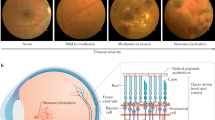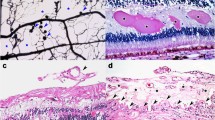Abstract
Physiologic adaptations mediate normal responses to short-term and long-term stresses to ensure organ function. Organ failure results if adaptive responses fail to resolve persistent stresses or maladaptive reactions develop. The retinal neurovascular unit likewise undergoes adaptive responses to diabetes resulting in a retinal sensory neuropathy analogous to other sensory neuropathies. Vision-threatening diabetic retinal neuropathy results from unremitting metabolic and inflammatory stresses, leading to macular edema and proliferative diabetic retinopathy, states of “retinal failure.” Current regulatory strategies focus primarily on the retinal failure stages, but new diagnostic modalities and understanding of the pathophysiology of diabetic retinopathy may facilitate earlier treatment to maintain vision in persons with diabetes.


Similar content being viewed by others
References
Papers of particular interest, published recently, have been highlighted as: • Of importance •• Of major importance
Grading diabetic retinopathy from stereoscopic color fundus photographs—an extension of the modified Airlie House classification. ETDRS report number 10. Early Treatment Diabetic Retinopathy Study Research Group. Ophthalmology. 1991;98(5 Suppl):786-806.
Antonetti DA, Klein R, Gardner TW. Diabetic retinopathy. N Engl J Med. 2012;366(13):1227–39.
Widmaier EP, Raff H, Strang K. Vander’s human physiology: the mechanisms of body function. New York: McGraw-Hill; 2011. Details the general physiologic mechanisms of normal adaptive processes.
Eaton DC, Pooler JP. Renal functions, basic processes, and anatomy. In: Eaton DC, Pooler JP, editors. Vander’s renal physiology. New York: McGraw-Hill; 2013. p. 1–19.
Moreno JA, Radford H, Peretti D et al. Sustained translational repression by eIF2alpha-P mediates prion neurodegeneration. Nature. 2012;485(7399):507–11.
Barrett KE, Barman SM, Boitano S et al. Circulation through special regions. In: Barrett KE et al., editors. Ganong’s review of medical physiology. New York: McGraw-Hill; 2012.
Pop-Busui R, Herman WH, Feldman EL et al. DCCT and EDIC studies in type 1 diabetes: lessons for diabetic neuropathy regarding metabolic memory and natural history. Curr Diab Rep. 2010;10(4):276–82. Summarizes the major findings from the DCCT/EDIC regarding neuropathy in T1DM.
Bargman JM, Skorecki K. Chronic kidney disease. In: Longo DL et al., editors. Harrison’s principles of internal medicine. New York: McGraw-Hill; 2012.
Edwards JL, Vincent AM, Cheng HT et al. Diabetic neuropathy: mechanisms to management. Pharmacol Ther. 2008;120(1):1–34.
Zochodne DW. Mechanisms of diabetic neuron damage: molecular pathways. Handb Clin Neurol. 2014;126:379–99.
Katirji B, Koontz D. Disorders of peripheral nerves. In: Daroff RB et al., editors. Bradley’s neurology in clinical practice. Philadelphia: Elsevier Saunders; 2012. p. 1977–82.
Kennedy JM, Zochodne DW. Impaired peripheral nerve regeneration in diabetes mellitus. J Peripher Nerv Syst. 2005;10:144–57.
Wolter JR. Diabetic retinopathy. Am J Ophthalmol. 1961;51:1123–39.
Callaghan BC, Little AA, Feldman EL et al. Enhanced glucose control for preventing and treating diabetic neuropathy. Cochrane Database Syst Rev. 2012;6:CD007543. A critical review of the effects of glucose control for diabetic neuropathy.
Calabek B, Callaghan B, Feldman EL. Therapy for diabetic neuropathy: an overview. Handb Clin Neurol. 2014;126:317–33.
Petropoulos IN, Green P, Chan AW et al. Corneal confocal microscopy detects neuropathy in patients with type 1 diabetes without retinopathy or microalbuminuria. PLoS One. 2015;10(4), e0123517.
Pittasch D, Lobmann R, Behrens-Baumann W et al. Pupil signs of sympathetic autonomic neuropathy in patients with type 1 diabetes. Diabetes Care. 2002;25(9):1545–50.
Yau JW, Rogers SL, Kawasaki R et al. Global prevalence and major risk factors of diabetic retinopathy. Diabetes Care. 2012;35(3):556–64.
Abcouwer SF, Gardner TW. Diabetic retinopathy: loss of neuroretinal adaptation to the diabetic metabolic environment. Ann N Y Acad Sci. 2014;1311:174–90. Summarizes current knowledge of neurovascular adaptations in diabetic retinopathy.
Kuschinsky W. Neuronal-vascular coupling. A unifying hypothesis. Adv Exp Med Biol. 1997;413:167–76.
Bill A, Sperber GO. Control of retinal and choroidal blood flow. Eye. 1990;4(Pt 2):319–25.
Kur J, Newman EA, Chan-Ling T. Cellular and physiological mechanisms underlying blood flow regulation in the retina and choroid in health and disease. Prog Retin Eye Res. 2012;31:377–406.
Lott ME, Slocomb JE, Shivkumar V et al. Comparison of retinal vasodilator and constrictor responses in type 2 diabetes. Acta Ophthalmol (Copenh). 2012;90(6):e434–41.
Garhofer G, Zawinka C, Resch H et al. Reduced response of retinal vessel diameters to flicker stimulation in patients with diabetes. Br J Ophthalmol. 2004;88(7):887–91.
Hellgren KJ, Agardh E, Bengtsson B. Progression of early retinal dysfunction in diabetes over time: results of a long-term prospective clinical study. Diabetes. 2014;63(9):3104–11.
Harrison WW, Bearse MA Jr, Schneck ME et al. Prediction, by retinal location, of the onset of diabetic edema in patients with nonproliferative diabetic retinopathy. Invest Ophthalmol Vis Sci. 2011;52(9):6825–31.
Tzekov R, Arden GB. The electroretinogram in diabetic retinopathy. Surv Ophthalmol. 1999;44(1):53–60.
Fort PE, Losiewicz MK, Pennathur S et al. mTORC1-independent reduction of retinal protein synthesis in type 1 diabetes. Diabetes. 2014;63(9):3077–90.
van Guilder HD, Brucklacher RM, Patel K et al. Diabetes downregulates presynaptic proteins and reduces basal synapsin 1 phosphorylation in rat retina. Eur J Neurosci. 2008;28:1–11.
D’Cruz TS, Weibley BN, Kimball SR et al. Post-translational processing of synaptophysin in the rat retina is disrupted by diabetes. PLoS One. 2012;7(9), e44711.
Barber AJ, Gardner TW, Abcouwer SF. The significance of vascular and neural apoptosis to the pathology of diabetic retinopathy. Invest Ophthalmol Vis Sci. 2011;52(2):1156–63.
Lasta M, Pemp B, Schmidl D et al. Neurovascular dysfunction precedes neural dysfunction in the retina of patients with type 1 diabetes. Invest Ophthalmol Vis Sci. 2013;54(1):842–7.
Sharma K, Karl B, Mathew AV et al. Metabolomics reveals signature of mitochondrial dysfunction in diabetic kidney disease. J Am Soc Nephrol. 2013;24(11):1901–12.
Brosius 3rd FC, He JC. JAK inhibition and progressive kidney disease. Curr Opin Nephrol Hypertens. 2015;24(1):88–95.
Brosius FC, Coward RJ. Podocytes, signaling pathways, and vascular factors in diabetic kidney disease. Adv Chronic Kidney Dis. 2014;21(3):304–10.
Hirsch IB, Brownlee M. Beyond hemoglobin A1c—need for additional markers of risk for diabetic microvascular complications. JAMA. 2010;303(22):2291–2.
Jackson GR, Scott IU, Quillen DA et al. Inner retinal visual dysfunction is a sensitive marker of non-proliferative diabetic retinopathy. Br J Ophthalmol. 2012;96(5):699–703.
Gardner TW, Jackson GR. Early detection of neural dysfunction in diabetic retinopathy. In: Guthoff RF, Wiedemann P, editors. Nova Acta Leopoldina. 2014. p. 179–86.
DCCT/EDIC Research Group. Intensive diabetes therapy and ocular surgery in type 1 diabetes. N Engl J Med. 2015;372(18):1722–33.
DCCT/EDIC Research Group. Effect of intensive diabetes therapy on the progression of diabetic retinopathy in patients with type 1 diabetes: 18 years of follow-up in the DCCT/EDIC. Diabetes. 2015;64(2):631–42.
Acknowledgments
This study is supported by the Summer Biomedical Research Program at the University of Michigan Medical School (EG), EY20852 and DK094292, The Taubman Institute, and a Research to Prevent Blindness Physician-Scientist Award (TG). David Murrel, MFA, created the artwork.
Compliance with Ethics Guidelines
ᅟ
Conflict of Interest
Ellyn J. Gray declares that she has no conflict of interest.
Thomas W. Gardner reports personal fees from KalVista, Novo Nordisk, Johnson & Johnson, and Janssen and Puretech and other from BetaStem.
Human and Animal Rights and Informed Consent
This article does not contain any studies with human or animal subjects performed by any of the authors.
Author information
Authors and Affiliations
Corresponding author
Additional information
This article is part of the Topical Collection on Microvascular Complications—Neuropathy
Rights and permissions
About this article
Cite this article
Gray, E.J., Gardner, T.W. Retinal Failure in Diabetes: a Feature of Retinal Sensory Neuropathy. Curr Diab Rep 15, 107 (2015). https://doi.org/10.1007/s11892-015-0683-5
Published:
DOI: https://doi.org/10.1007/s11892-015-0683-5




